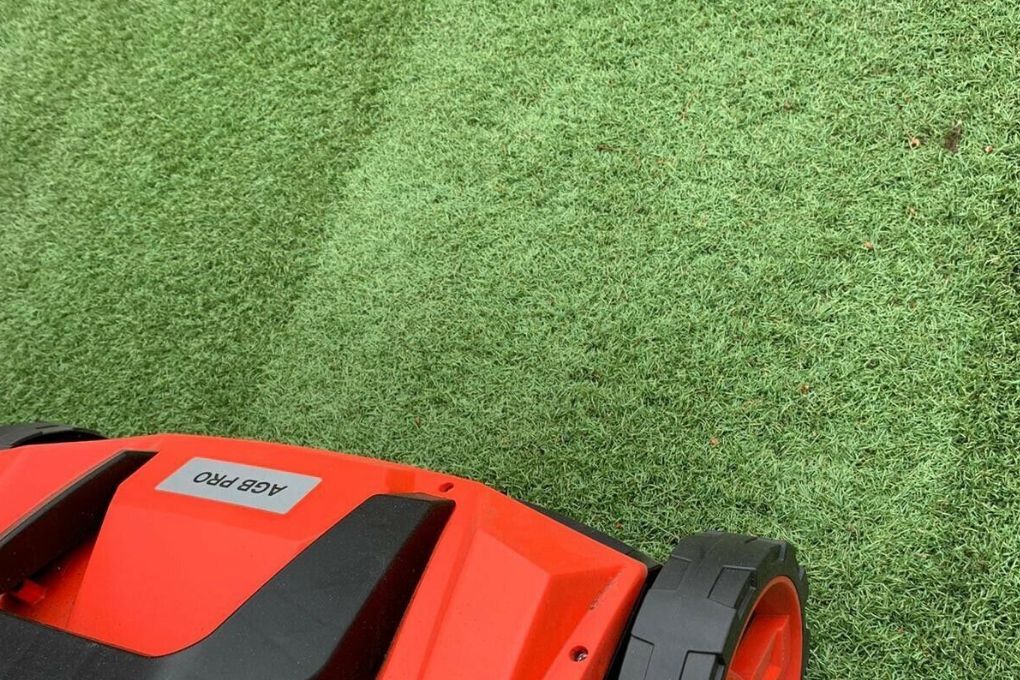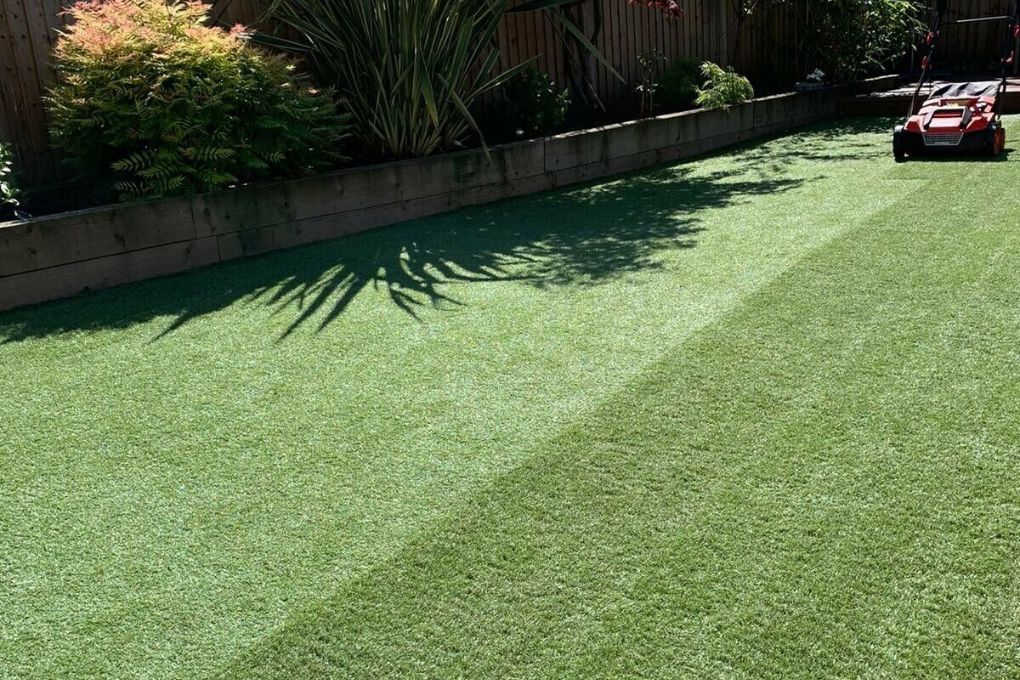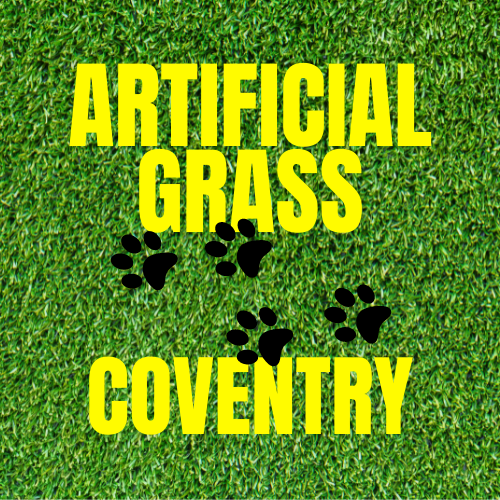Artificial Grass Maintenance Coventry
Artificial Grass Maintenance Service Coventry
Compared to the maintenance required to look after a real lawn an artificial lawn if much, much easier to maintain which is one of the reasons so many people are having them installed. However, if completely neglected they can become dirty over time and issues can start to occur even with a professionally installed fake lawn.
Regular cleaning of your artificial grass is essential to ensure its longevity and aesthetic appeal. To keep your artificial grass looking its best, it is important to regularly remove leaves and debris from the surface. This can be done with a leaf blower or simply by hand using a stiff brush or soft rake.
Additionally, applying weed killer specifically designed for artificial grass can minimise the possibility of weeds or moss growing, especially if you have areas of fake grass under dense trees or overhanging hedges. Alternatively, it’s better to trim back hedges and overhanging trees regularly in order to reduce the amount of leaves that fall onto the lawn. This will help keep your lawn looking neat and tidy all year round.
Hopefully, it should also go without saying that if you are a pet owner cleaning up after your animal as soon as possible is best practice.

Slide title
Write your caption hereButton
Slide title
Write your caption hereButton
INCLUDE YOUR MEASUREMENTS FOR A QUICK ARTIFICIAL GRASS MAINTENANCE PROVISIONAL QUOTE
SEND ANYTIME 24/7
Artificial Grass Coventry quote form
We will get back to you as soon as possible.
Please try again later.
ARTIFICIAL GRASS MAINTENANCE SERVICE
TO KEEP YOUR ARTIFICIAL LAWN LOOKING AMAZING ALL YEAR ROUND ASK ABOUT BOOKING OUR REGULAR ARTIFICIAL GRASS CLEANING AND MAINTENANCE SERVICE
Available to both our own artificial grass customers and existing owners of artificial grass lawns, sports pitches and commercial premises. Discounted rates available for regular bookings.
Looking after Artificial Grass
When looking after artificial grass one of the most important things is to avoid actions or activities which may cause irreversible damage to you fake lawn.
It is best practice to place BBQ's on a patio instead of directly on the artificial grass, and it is also advisable to inform any contractors who may be trimming trees that motorised tools, which could leak petrol or lubricant, should not be placed directly on the lawn. Any damage caused by these items will not be covered by any warranty, so please take care when using them near your synthetic turf.
Removing spillages from artificial turf can be a tricky task. The key is to act quickly and remove as much of the spillage as possible before it begins to harden. Soak up any liquids with a clean cloth or kitchen towel, which will absorb any liquid. If there is still a mark, mix a small amount of washing up liquid and lukewarm water together and apply with a synthetic bristled brush or a clean cloth or sponge before hosing down.
Cleaning Artificial Grass
Cleaning artificial grass is a lot easier than you might think. Contrary to popular belief, you won't have to clean your artificial grass every day. Rainwater will wash away most surface dirt and debris, so you don't need to worry about it becoming too dirty or matted down. However, we do recommend that you hose the lawn down once a week or once every other week to keep it looking its best. This will help remove any small bits of dirt and debris that may have accumulated on the surface of the grass and prevent it from becoming matted down over time.
For larger debris items such as leaves, brushing is also an important part of maintaining your artificial grass. This should be done at least once every few months, and more frequently over autumn, using a stiff brush or broom to help keep the blades upright and standing tall. When brushing artificial grass, it’s important to use gentle strokes in order to avoid damaging the fibres. It’s also important to make sure that all areas are brushed thoroughly in order to ensure that all dirt has been removed from the surface. After brushing, spraying your synthetic lawn with a detergent will also help remove certain stains that may have got onto the grass blades and not been loosened by brushing. Once it has been left according to the manufacturers' instructions it’s essential to rinse off any remaining detergent with water in order to prevent discoloration or damage over time. With regular maintenance and care, your artificial grass should remain looking great for years to come!
Artificial Grass Cleaning Service near me
Contact us any time of the day or night through our contact form if looking for an artificial grass cleaner
Maintaining Fake Grass
Weed killer should be considered as a preventative part of maintaining a fake grass lawn. Without it, the area can become overrun with weeds and other unwanted plants especially if you have not kept on top of debris and dirt build up. Applying weed killer twice a year to the entire area is helpful to keep the lawn looking its best. It's important to use a product that is specifically designed for artificial turf, as regular weed killers may not be as effective on synthetic grass.
It's important to remember that you should never use harsh chemicals on your artificial grass, as this could damage the fibres and cause discolouration. For tougher stains such as oil or grease, try using an enzyme-based cleaner specifically designed for artificial grass. This will help break down the stain without damaging the fibres. Once you've applied the cleaner, leave it for 10 minutes before rinsing off with lukewarm water and allowing it to dry naturally in the sun.
Need Help?
Deciding on whether to clean your artificial turf?
Frequently Asked Artificial Grass Maintenance Questions:
-
What DIY artificial grass maintenance do you recommend?
Whilst maintenance requirements for the grass itself are low, if you want to maintain the aesthetics here are some tips:
Regularly remove items that have fallen or been blown onto your artificial lawns such as leave and twigs which can degrade and engrain themselves into your turf. Using a brush, soft rake, or leave blower/vacuum should do the trick. If part of your lawn is in a very shaded area and much is allowed to build up moss could grow from it. applying a biodegradable anti- moss treatment will be fine - do not use bleach or other acid-based cleaning products. Other chemicals to keep away are oils, solvents, or fuels as they can damage the blades. Likewise, extreme heat can also damage your grass so cigarettes, barbeques, or fireworks where hot elements could drop onto your grass will cause blades to melt and fuse together. For snow and frost, these will not cause any damage so these can simply be left to melt away naturally.
Most of the care advise is fairly common sense and if followed you will enjoy your grass for many years
-
Do I need to keep brushing sand into my artificial grass as part of a maintenance programme?
Adding sand on top of your artificial grass as a final step is something that other artificial grass suppliers and installers may still do. This practice is generally associated with sports pitches and was something that needed to be done on a more regular basis for these astroturf pitches however, our domestic grasses do not, and nor do our 4G artificial turf sports pitches. We provide a no-fill 4G pitch which also means no additional small rubber crumbs need to be added and brushed in either. These practises are generally associated with 2G and 3G artificial grass pitches.
-
Why use DNA Artificial Grass Coventry for our fake lawn maintenance
We are installers so we have a thorough understanding of the materials we use and therefore understand what the best way to look after these are from the manufacturer.
-
What do you do as part of your artificial grass maintenance service
We undertake a several step process as part of our maintenance service. The first step is to remove any large weeds and surface debris. This is then followed up by running over the lawn with an artificial grass rejuvinator which loosens smaller dirt and lifts flattened down areas. We then apply a cleaner to the lawn to act on any dirt or stains attached to the blades before hosing this down. we then run power brush along the whole lawn to brink all the blades up the the same level which freshens up the appearance of the whole lawn. Finally we apply special artificial grass disinfectant and weed killer to keep things looking good for as long as possible until our next visit.

